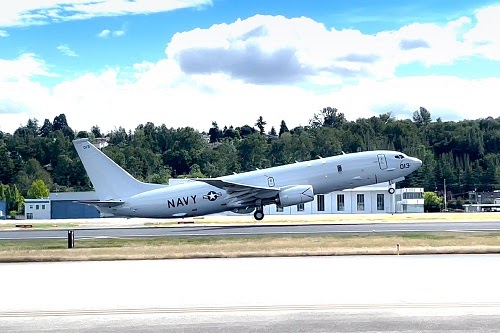
US officials believe Indian Navy’s fleet of 12 Poseidons could grow to 25-35 aircraft
By Vikas Gupta
Defence News of India, 9 Jul 22
In 2013, the US and Indian navies became the first to fly Boeing’s new P-8 Poseidon multi-mission maritime patrol and reconnaissance aircraft. On Thursday, the 150th Poseidon took off over Puget Sound in Seattle.
During the 450,000 hours of accident-free flight, the Poseidon has been recognized as the most formidable submarine hunter in the world. Its list of users grew rapidly: India operationalized a fleet of 12 Poseidons, the US Navy purchased 112; the Royal Navy flies 9, the Australian Navy operates 12 and the Norwegian Navy has five. New Zealand will join the list of Poseidon users later this year, South Korea in 2023 and Germany in 2024.
“There are now 150 P-8s in the world that deliver unparalleled confidence and capability to our global customers,” said Stu Voboril of P-8 Programs, Boeing. “Our goal has been and will be to provide the best maritime patrol aircraft in the world.”
In 2009, the Indian Navy signed a contract for eight P-8I aircraft for US$2.1 billion, which were delivered ahead of schedule. This contract included options for four additional aircraft, for which another billion-dollar contract was signed in 2016.
The Navy’s purchase of 12 P-8I aircraft for US$3.1 billion and Washington’s decision to supply them to India alongside the first deliveries to the US Navy highlighted two major changes. First, a new willingness in Washington to sell advanced weapons to New Delhi without boring quibbling about “changing the regional arms balance.” Second, the purchase of the P-8I demonstrated New Delhi’s willingness to spend top dollar to support its regional ambitions with high-end military capabilities.
Based at INS Rajali, a naval air base in Arakonam, near Chennai, the P-8Is – designated Indian Naval Air Squadron 312-A – fly 8-hour missions over the Indian Ocean to search for pirates, cargo ships suspicious, hostile warships and submarines. Its upgraded internal fuel tanks allow it to travel 1,100 kilometers to a point of interest, patrol the area for six hours, and then return 1,100 kilometers to Arakonam. With in-flight refueling, this autonomy can be doubled.
The P8-I consists of advanced sensors and weapons integrated into a Boeing 737-800, modified with the improved wings of a 737-900 which allow the transport of weapons. It combines a tried and tested suite of sensors and weapons with a specially developed Boeing 737. With reliability and endurance being crucial, it made sense to base the Poseidon on the world’s most-used airliner (a 737 lands or takes off somewhere in the world every three seconds).
The CFM-56 engines fitted as standard on recent 737s also equip the Poseidon. These are modified with larger generators that produce power for the MMA’s sensors and control systems. Additionally, there is an auxiliary power unit that provides power even when the main engines are off.
The punch of the P-8I lies in its sophisticated sensors. A multi-mode radar detects aircraft, surface ships and submarines. Another belly-mounted radar looks to the rear, like an electronic rear-view mirror. Any suspected threats could be investigated further: sonobuoys are dropped to zero on suspected enemy submarines, radioing back any suspicious sounds they pick up. A submarine would also be picked up by a Magnetic Anomaly Detector (MAD) on the tail of the P-8I.
To face these threats, the Poseidon is armed to the teeth. It has 11 “hardpoints”, or weapon stations: two under each wing for Mark 82 depth charges or Harpoon anti-ship missiles; five stations inside the weapons bay for Mark 54 torpedoes which cannot be launched outside as they must be kept warm; and two forward hardpoints for combat search and rescue (SAR) equipment or additional depth bombs.
Alternatively, the P8-I, which is linked to Indian submarine data, can transmit the location of the enemy submarine. Indian submarines can then concentrate on the intruder and fire torpedoes to destroy it.
US officials are optimistic about India’s eventual purchase of 25 to 35 Poseidons, given the growing need for “maritime domain awareness” in the Indian Ocean, where the Indian Navy plays the role of regional guardian.
These tasks were previously carried out by the Indian Navy’s Tupolev-142 Bear long-range maritime patrol aircraft, purchased from the Soviet Union in 1988. With the arrival of the Poseidons, the Tupolev-142 fleet was withdrawn in 2017.
To augment the surveillance and reconnaissance capability provided by twelve P8-Is, the Navy is also acquiring eight new medium-range maritime reconnaissance (MRMR) aircraft and a fleet of unmanned aerial vehicles (UAVs) Sea Guardian.






